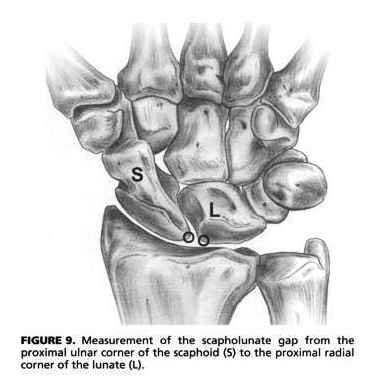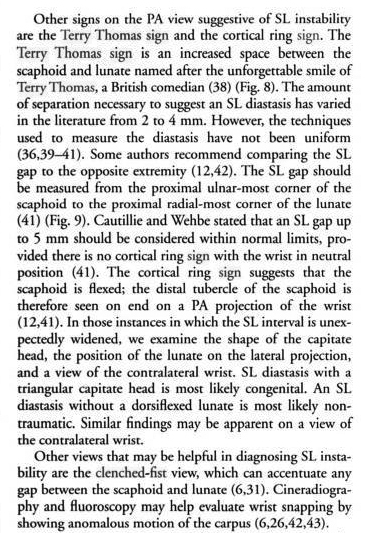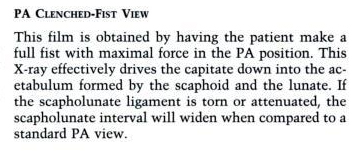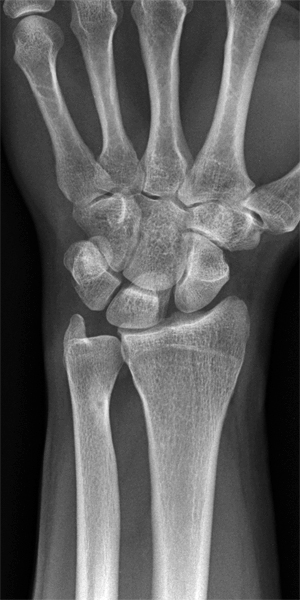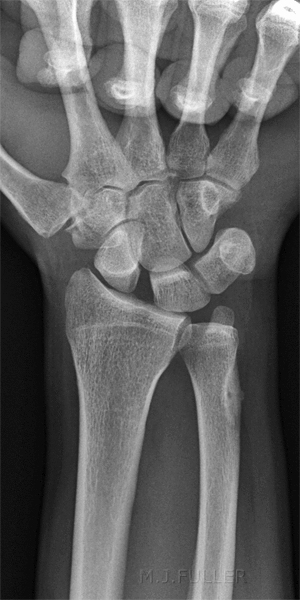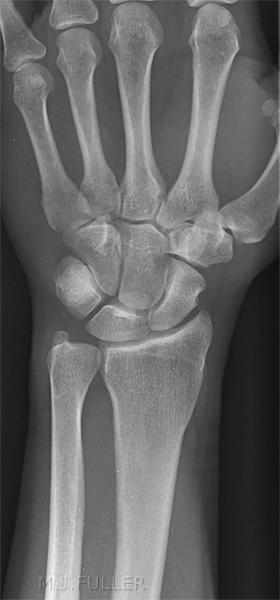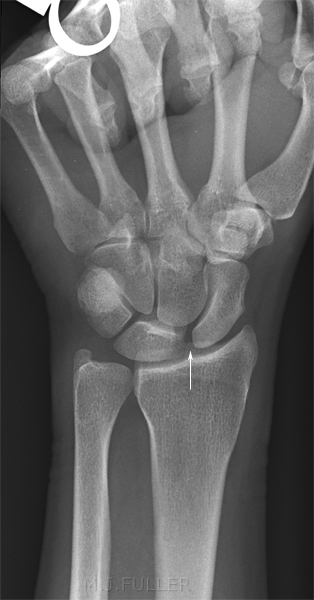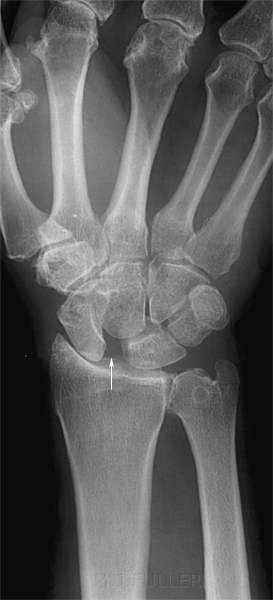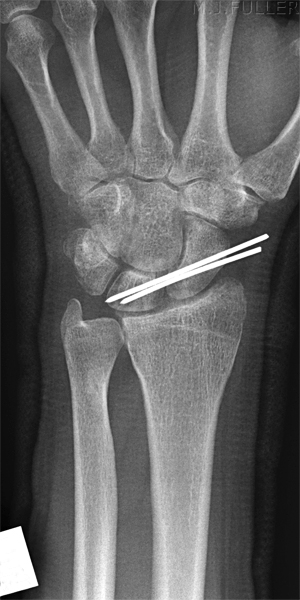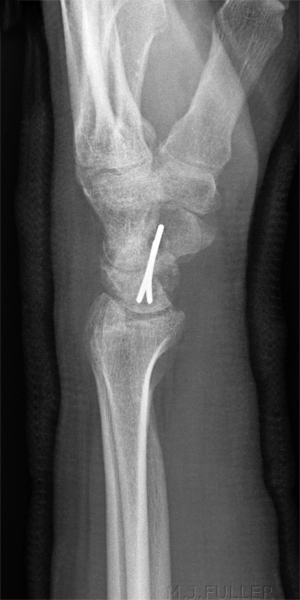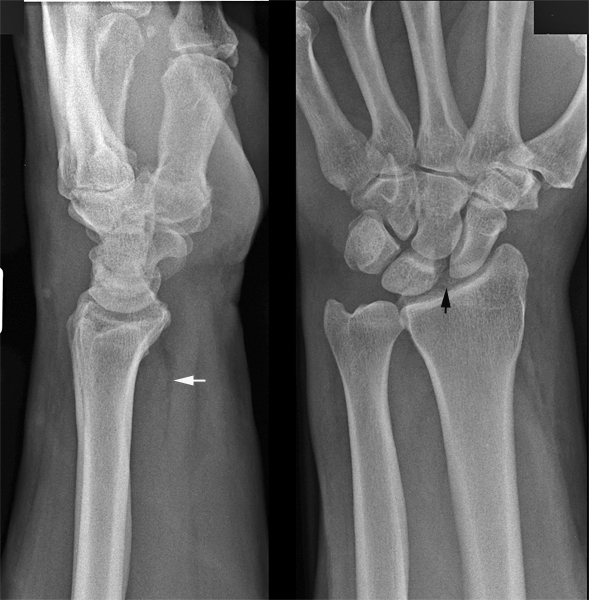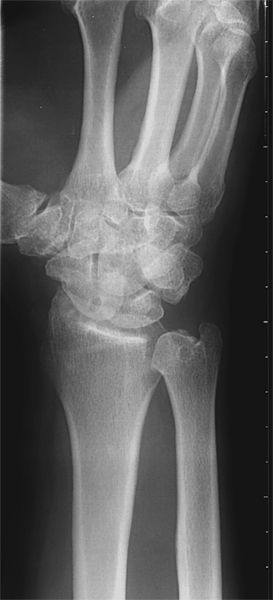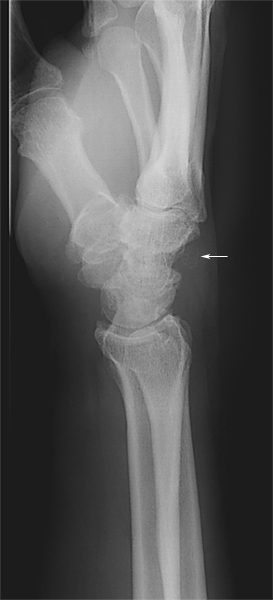The Terry-Thomas Sign
The following text provides some useful background information on the Terry Thomas sign.
| "The most common widened carpal joint space is that of the scapholunate. Nicknamed the "Terry-Thomas sign" by Frankel ...., widening at this joint has been variously defined as anything from 2 mm [Ref Moneim, JBJS 1981; Linscheid, JBJS, 1972 ] to 4 mm... Absolute magnitudes are difficult to define and more difficult to justify: the magnification of the film is rarely available. Relative widening at this joint is simple and easy to determine. As mentioned above, however, the scapholunate joint has a varying profile, from its proximal to its distal margin, due to the rounded contour of the scaphoid’s lunate facet. Additionally there is variance in the width of the scapholunate joint in its dorsal, middle and palmar aspects. ..., however, the narrowest aspect of the joint in the same coronal plane should be measured, not the most proximal part (which would make most joint spaces seem wide) or the most distal part. Cautilli and Webbe [JHS 1991] have suggested that the measurement be taken at the proximal border of these bones, and found a mean of 3.7 mm with a range from 2.5 to 5.0 mm. However, there is no control for the magnification of the film, the size of the patient, and they note that "the scaphoid’s proximal pole is rounded, making measurement more difficult." Given the inaccuracies inherent in their method, and the built-in control and ease of definition of the standard method, we recommend the scapholunate gap be measured as the narrowest gap between the two bones when measured in the midpoint of adjacent parallel articular contours. Optimally this measurement should be made on a view profiling the scapholunate joint, often with fluoroscopic control .... Dr. Frankel graciously obtained the actor’s permission before naming a pathological entity after him. Readers not familiar with the comic actor’s famous diastasis in his front teeth are referred to Dr. Frankel’s article. Mr. Terry-Thomas kindly provided two pictures of himself for publication in CORR. The joint space must be properly profiled in order to make a precise determination of its width. This may be more difficult that it first appears, because often the joint line of interest is not properly profiled. Joint lines that are apparently well-profiled may not be so, upon closer examination. ...Fluoroscopic evaluation of the wrist between radial and ulnar deviation in both supine and prone positions allows optimal evaluation of the scapholunate joint space. The suspected widened scapholunate joint space must be compared to the opposite side to exclude the occasional borderline normally wide scapholunate joint space." | ||
| <a class="external" href="http://www.hand-therapy.com/images/Radiology_100500.pdf" rel="nofollow" target="_blank">RADIOLOGY OF THE WRIST Presented by Karen Nugent, PT, CHT and David Nelson, M.D. At the 23rd Annual Meeting of the American Society of Hand Therapists 5 October 2000</a> | <a class="external" href="http://www.hand-therapy.com/images/Radiology_100500.pdf" rel="nofollow" target="_blank"> </a> | |
Measuring the Scapholunate Distance
<a class="external" href="http://books.google.com.au/books?id=b7-kkx-8eqYC&pg=PA485&lpg=PA485&dq=terry+thomas+sign+clenched+fist&source=bl&ots=DqTjyisJXc&sig=_yThM9e-Svrf0kHRks30TxkCnRA&hl=en&ei=DOLdSffGBtSJkQXn3LmrDA&sa=X&oi=book_result&ct=result&resnum=6#PPA485,M1" rel="nofollow" target="_blank">By Richard A. Berger, Arnold-Peter C. Weiss. Hand surgery</a>
quoted from<a class="external" href="http://books.google.com.au/books?id=b7-kkx-8eqYC" rel="nofollow" target="_blank">Hand surgery</a><a class="external" href="http://books.google.com.au/books?id=b7-kkx-8eqYC" rel="nofollow" target="_blank">By Richard A. Berger, Arnold-Peter C. Weiss</a><a class="external" href="http://books.google.com.au/books?id=b7-kkx-8eqYC" rel="nofollow" target="_blank">Edition: illustrated</a><a class="external" href="http://books.google.com.au/books?id=b7-kkx-8eqYC" rel="nofollow" target="_blank">Published by Lippincott Williams & Wilkins, 2003</a>
Radiography
The PA Clenched Fist View - used to evaluate widening of scapholunate interval;
- clenching the first draws the capitate proximally and emphasizes any widening of scapho-lunate interval
- should get companion views of the opposite side for comparison
- best taken with supinated clenched fist view with wrist in ulnar deviation
- AP x-rays made with wrist in ulnar deviation (increases gap), in radial deviation (decreases gap), & with application of longitudinal compressive load
(clenched fist) may also show widened scapholunate gap in wrist with scapholunate dissociation (SLD)
- Technique:
- same technique as <a class="external" href="http://www.wheelessonline.com/ortho/posterior_anterior_view_of_the_wrist" rel="nofollow" target="_blank">PA view</a> of wrist except patient clenches fist as tightly as possible during exposure;
- proper technique for visualizing scapholunate interval;
- gap is more noticeable on AP View that is made with wrist supinated than it is on more usual PA view (made with wrist pronated);
quoted from
<a class="external" href="http://www.wheelessonline.com/ortho/clenched_fist_ap" rel="nofollow" target="_blank">Wheeless' Textbook of Orthopaedics</a>
<a class="external" href="http://books.google.com.au/books?id=IOKGBsOoJi0C&pg=PA15&lpg=PA15&dq=wrist+parallelism&source=bl&ots=qpHXwaaCyX&sig=m293PMacaIeQY8FcpFZh-EYAjoY&hl=en&ei=aGYOSsLNIdWLkAX3_5GmBA&sa=X&oi=book_result&ct=result&resnum=5#PPA20,M1" rel="nofollow" target="_blank">
</a><a class="external" href="http://books.google.com.au/books?id=IOKGBsOoJi0C&pg=PA15&lpg=PA15&dq=wrist+parallelism&source=bl&ots=qpHXwaaCyX&sig=m293PMacaIeQY8FcpFZh-EYAjoY&hl=en&ei=aGYOSsLNIdWLkAX3_5GmBA&sa=X&oi=book_result&ct=result&resnum=5#PPA20,M1" rel="nofollow" target="_blank">William Geissler Wrist Arthroscopy, 2005</a>
Plain Film Appearance
Findings in Scapholunate Dissociation
- scapholunate interval > 2-3 mm (Terry Thomas sign);
- cortical ring sign:
- produced by cortex of distal pole of palmar flexed scaphoid;
- produced by cortical outline of the distal pole of scaphoid;
- scaphoid is foreshortened;
- distance between scaphoid ring & proximal pole is < 7 mm;
- negative ulnar variance:
- - ulnar deviation, increases scapholunate gap;
- - radial deviation, closes gap;
quoted from<a class="external" href="http://www.wheelessonline.com/ortho/clenched_fist_ap" rel="nofollow" target="_blank">Wheeless' Textbook of Orthopaedics</a>
Scapholunate dissociation plain film findings<a class="external" href="http://www.surgeons.org/Content/NavigationMenu/WhoWeAre/Regions/VIC/BMiller_050701.pdf" rel="nofollow" target="_blank">adapted from Classification of Carpal Instability Ben Miller July 2005</a>
- Dorsal Scapholunate ligament of primary importance
- DISI deformity – lunate extended by triquetrum
- scaphoid collapses into flexion;
- rotary subluxation of scaphoid
- Scapholunate interval > 3mm on clenched fist view
- Scaphoid signet ring sign; foreshortened scaphoid
- triangular lunate
Treatment
This is a PA wrist image (? in fibreglass cast) with two K wires stabilising a scapholunate ligament tear Lateral image of same
Case 1
The Terry Thomas sign (black arrow) refers to the increased distance between the scaphoid and the lunate. This sign can indicate a rupture of the scapho-lunate ligament.
The origins of the term should be discernible from this photograph of Terry Thomas
The other sign is the pronator quadratus soft tissue sign (white arrow). This is a bowing of the facial covering of the pronator quadratus muscle and indicates significant injury to the wrist and a higher chance of bony injury.
(more information on the pronator quadratus sign at <a class="external" href="http://radiology.rsnajnls.org/cgi/reprint/244/3/927.pdf" rel="nofollow" target="_blank">http://radiology.rsnajnls.org/cgi/reprint/244/3/927.pdf</a>)
Case 2
67 year old man with wrist pain and unknown history.
... back to the Applied Radiography home page
